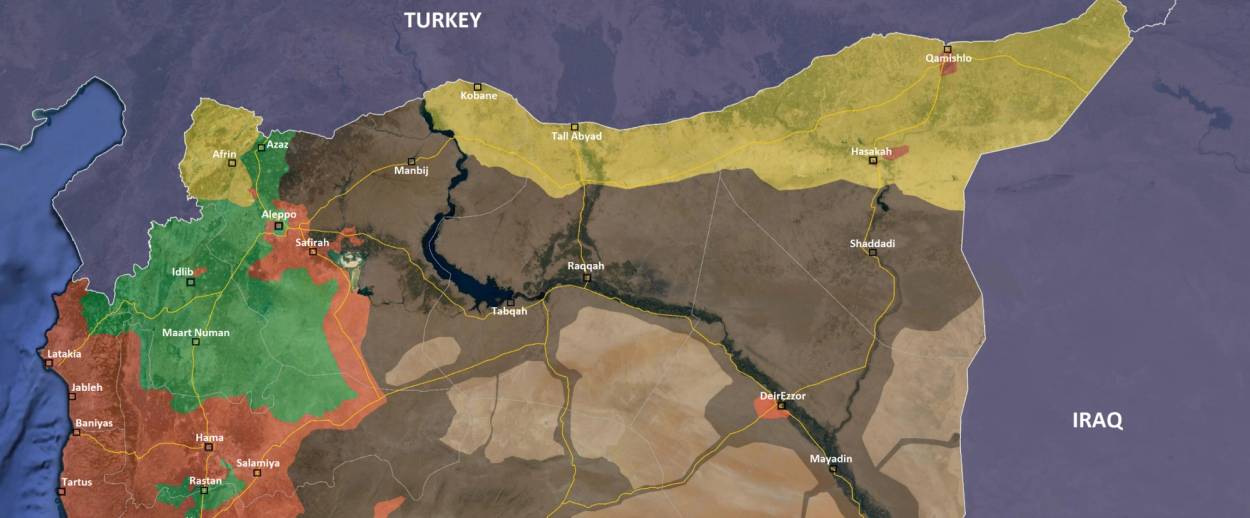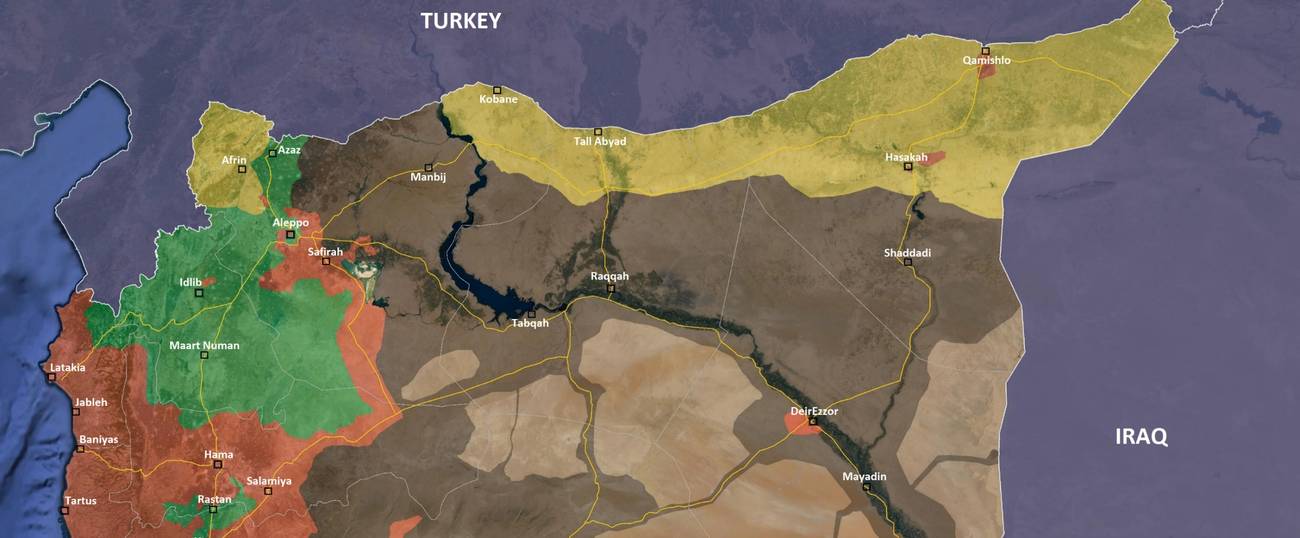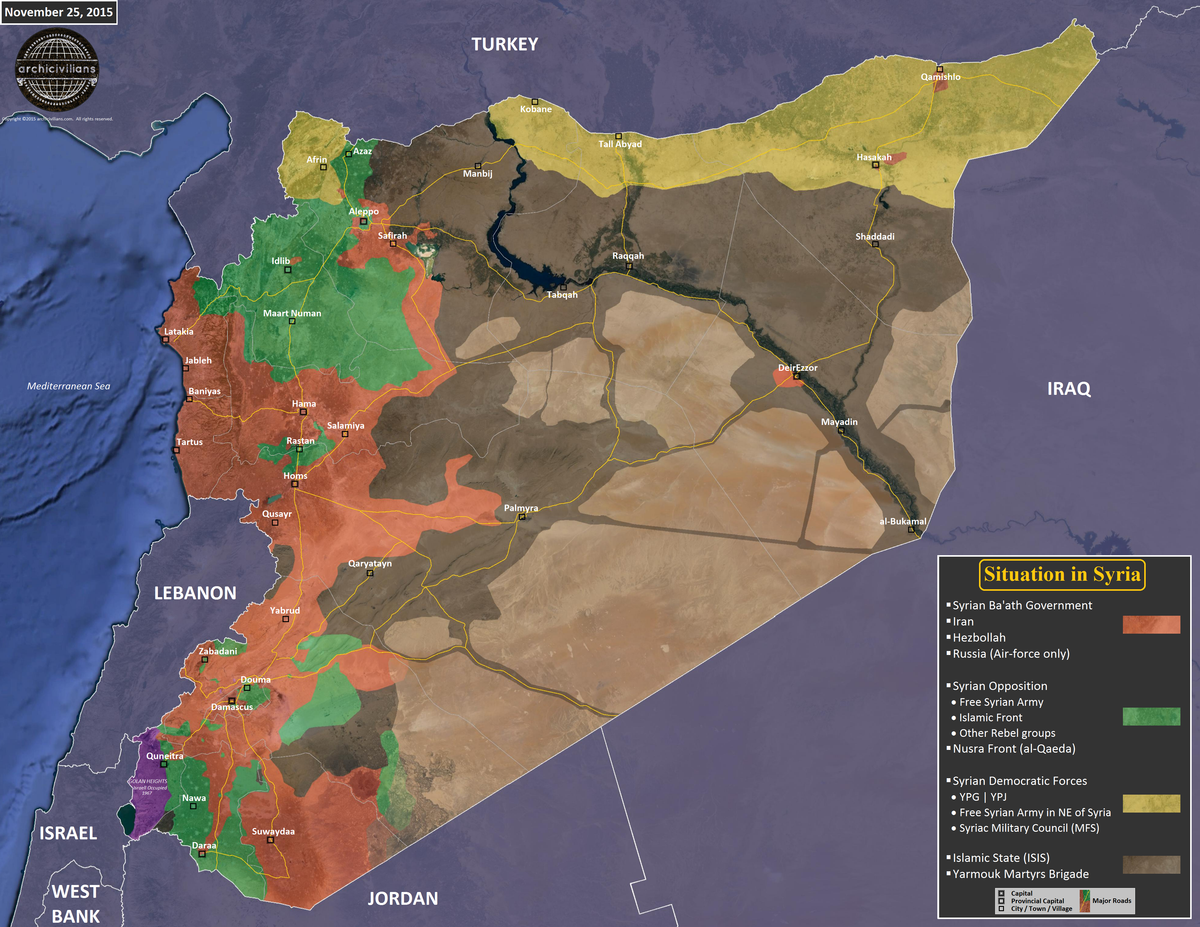Understanding Syria: Whose Side Are We on, Anyway?
It helps to look at this map




The White House and the Kremlin are currently working in parallel toward a common objective in Syria: cutting off support to Syrian rebels fighting the Assad regime by closing the Turkish-Syrian border. What makes this situation confusing, even to many reporters and commentators, is that it is being promoted as an effort to “fight ISIS.” The irony is that, to achieve his goals, Vladimir Putin is using both ISIS as well as a U.S.-supported, anti-Turkish Kurdish group.
It is no secret that Russia entered Syria to support the country’s dictator, Bashar al-Assad. As a result, Putin has shown very little interest in fighting ISIS, which has allied militarily and economically with Assad against other rebel groups, which it seeks to destroy. As a result, clashes between Assad and ISIS have been very limited. Instead, they have ganged up against these rebels in what often seems like coordinated offensives. Russia’s own military operations have almost entirely targeted Turkish-backed rebel factions in northwestern Syria, which oppose ISIS, and which had achieved success in driving out Assad’s forces from Idlib province earlier in the spring. Russia’s immediate military goal is to roll back those gains.
Weapons and logistical support flow to the anti-Assad rebels from staging points in Turkey. In order to cut off support to the rebels, the Russians baited the Turks by violating their airspace last month, despite repeated warnings to stay out. The stunt resulted in the downing of a Russian Sukhoi fighter jet. However, the Russians immediately used the incident to pursue a multi-pronged attack on Turkish allies and interests in northern Syria and on Turkey itself, in what increasingly seems like a deliberate trap in which the Turks are now caught.
The Russian propaganda effort in support of the military campaign against the rebels aims to portray Turkey as the state sponsor of ISIS, thereby isolating the Turks in the wake of the ISIS terror attacks in Paris. Russian military operations, the Kremlin proclaimed, were targeting oil installations, and arms convoys from Turkey to ISIS. But the area the Russian air force was striking while those pictures were being released by Kremlin-controlled news outlets was an ISIS-free area north of Aleppo, close to the Turkish border.
The current Russian offensive is centered on and around the rebel-controlled town of Azaz, which lies in a narrow stretch between a Kurdish-controlled area to the west, and ISIS-controlled territory to the east. This strip is of great importance, as it constitutes the logistical conduit from Turkey to Syrian rebels in and around Aleppo who are fighting both ISIS, as well as the Iranian-led coalition of Shiite militias and Assad forces.
In addition to attacking these rebel areas on the Turkish border with air strikes, this week the Russian Air Force also reportedly gave support to Kurdish-led units that were attacking rebel positions near Azaz. At the same time, the Russians, working with the Iranians and regime forces, had been launching operations in the south and south east of Aleppo, thereby keeping rebel forces engaged on multiple fronts. By pounding Azaz and adding a Kurdish-led assault from the west, Putin deliberately gave an opening to ISIS to move in from the east and try to gain control over the critical border town. Indeed, ISIS swiftly launched an assault on nearby villages and is now threatening to advance on Azaz, thereby acting in concert with Putin and Iran against the anti-Assad rebels.
With this ploy, Putin is looking to hit several birds with one stone. By drawing in ISIS further west on the border with Turkey, he neutralizes the charge that his operations are not focused on ISIS, but rather on Assad’s opponents. Also, by working with the Kurds, he is laying his own claim to a force that Washington and its European allies regard as their partner of choice on the ground. By creating an opening for ISIS to make a push toward Azaz, Putin will leverage the US and Europe to pressure Turkey to shut down this section of its border. If ISIS actually makes it to Azaz, then Russia can then invite the U.S. and the Europeans to join it in strikes against ISIS, and in support of the Kurds.
But all of that is what professionals like to call “optics,” meaning appearances, which can often be at odds with facts and goals. Putin’s larger immediate goal is to shut down Turkey’s link to Aleppo, thereby preparing the way for Assad (perhaps even in coordination with the PKK-affiliated Kurds) to besiege and eventually recapture the city. In doing so, he will have used both ISIS and the Kurds to advance his plan of undercutting Turkey and buoying Assad. Sure enough, Russian foreign minister Sergei Lavrov explicitly confirmed yesterday that Russsia’s objective was to use the Kurds in order to seal off the Turkish border. “As for specific ways of sealing the border between Turkey and Syria,” Lavrov said, “Kurdish militia forces, which are allies of the US-led coalition, could be used.” U.S. special forces could also take part in the effort, Lavrov added, but they would have to coordinate with the Syrian government.
For its part, the White House has issued public statements that make it hard for casual observers to tell whether America is for or against Assad—who, after all, has murdered a quarter of a million of his own civilian population with barrel bombs, poison gas, and other outlawed methods of warfare—or whether we are opposed to Russia’s military intervention in Syria, or whether we are, in fact, allied with Putin. But a look at American policy statements and at a map of Syria (below), rather than sound bites, makes the picture much clearer. The White House has rejected Turkish proposals to set up a buffer zone in the border strip near Azaz. In fact, the Obama Administration has been working with the PKK-affiliated Kurds of the Democratic Union Party (PYD) precisely to avoid working with the anti-Assad rebels who are supported by the Turks and Saudis, which might upset Iran. The PYD Kurds are a perfect partner for American policy, because they have no interest in fighting Assad, and are content to work with the U.S. against ISIS and to strengthen their own position in northern Syria.
Following the downing of the Russian jet, Obama didn’t defend Turkey, which was once a key American ally, and remains a member of NATO. Instead, he has amplified Putin’s pressure on Turkey. The White House publicly pressured Turkey to cordon off a 60-mile stretch of its border that the administration says is used by ISIS to move foreign fighters to Syria. However, according to reporting by The Wall Street Journal, part of that stretch includes the area south of the Turkish town of Kilis, which sits opposite of Azaz, and extends eastward all the way to where the ISIS-held areas begin. In other words, the U.S. is demanding Turkey close down its border opposite areas held by non-ISIS rebel forces; those are the same areas that Putin is pummeling and wants cut off from Turkey. This policy aligns the U.S. with Russia, and therefore with Iran and Assad, against Turkey and the other regional backers of the Syrian rebels.

Tony Badran is Tablet’s news editor and Levant analyst.